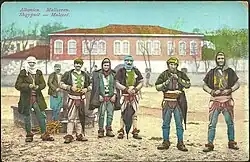Progoni family
The Progoni family was an Albanian noble family which established the first Albanian state to be recorded in history, the Principality of Arbanon.[1][2][3]
| Part of a series on |
| Albanian tribes |
|---|
 |
| Progoni family | |
|---|---|
| Titles | princeps Arbanorum panhypersebastos megas archon archon judex |
History
Progon of Kruja, father of Dhimitër Progoni established his rule in Krujë in 1190. Before 1204, Arbanon was an autonomous principality of the Byzantine Empire.[4] Little is known about archon Progon who ruled Krujë and its surroundings at least since the era between 1190 and 1198.[5] The Krujë Castle and other territories remained in the Progoni, and Progon was succeeded by his sons Gjin, and later Demetrio Progoni.[6] He used the title princeps Arbanorum ("prince of the Albanians") to refer to himself and was recognized as such by foreign dignitaries. In the correspondence with Innocent III, the territory he claimed as princeps Arbanorum was the area between Shkodra, Prizren, Ohrid and Durrës (regionis montosae inter Scodram, Dyrrachium, Achridam et Prizrenam sitae).[7] In general, Progoni brought the principality to its climax.[8] The area the principality controlled, ranged from the Shkumbin river valley to the Drin River valley in the north and from the Adriatic sea to the Black Drin in the east.[9] Many later feudal rulers of Albania would lay claim to the same title and present their rule as the continuation of this state. The first to do so was Charles I of Anjou who sought to legitimize the Kingdom of Albania as a descendant state of the Principality of Arbanon about 60 years later, in 1272.[10] After Dhimitër Progoni's death and by 1256, Arbanon would be annexed by the reemerging Byzantine Empire. He had no sons, but left as his successor his nephew Progon as protosebastos of Ndërfandë (Mirdita).
The rule of this Progon in the Mirdita area, the many similarities between the emblem of the Progoni family in the Gëziq inscription and the coat of arms of the later Dukagjini family and the claim of the Dukagjini that they were the hereditary overlords of Ndërfandë and the abbacy of Gëziq has led historians to consider that the two clans may have been related or even that the Dukagjini were descendants of the Progoni via protosebastos Progon.[11]
Members
- Progon (fl. 1190–1198), archon of Kruja
- Gjin (fl. 1198–1208), lord of Kruja
- Dhimitër (fl. 1208-1215/16), princeps Arbanorum(prince of the Albanians), megas archon, panhypersebastos
- Progon, protosebastos of Ndërfandë (Mirdita), son of Gjin[11]
See also
References
Citations
- Ducellier 1999, p. 780: "As for Albania, its separate identity was real enough, even though it had not truly broken with Constantinople; all the same, the rulers of Arbanon around ἄρχον, Progon and his sons Dhimitër and Gjin, based at Kruja, retained a considerable degree of autonomy, even though Progon bore no title grander than ἄρχων (archon); and the title of πανὑπερσεβαστός (panhypersebastos), borne by Dhimitër at the start of the thirteenth century, can only be seen as a sign of his dependence on the Byzantines."
- Clements 1992, p. 31: "By 1190, Byzantium's power had so receded that the archon Progon succeeded in establishing the first Albanian state of the Middle Ages, a principality."
- Fine 1994, p. 51"At the close of the twelfth century, excluding the tribesmen in the mountains, many of whom functioned freely regardless of which state they owed theoretical submission, the only known Albanian political entity was that of Kroja."
- Osswald 2007, p. 134
- Fine 1994, p. 51.
- Ducellier 1981, p. 646.
- Haluščynskyj 1954, p. 338
- Anamali & Prifti 2002, p. 198
- Frashëri 2008, p. 73.
- Lala 2008, p. 18
- Zamputi 1984, p. 218
Sources
- Anamali, Skënder; Prifti, Kristaq (2002). Historia e popullit shqiptar në katër vëllime: Shqiptarët gjatë luftës së dytë botërore dhe pas saj, 1939-1990. Botimet Toena. ISBN 978-99943-1-452-2.
- Clements, John (1992). Clements' Encyclopedia of World Governments. Vol. 10. Dallas, TX: Political Research, Incorporated.
- Ducellier, Alain (1981). La façade maritime de l'Albanie au Moyen âge. École des Hautes Études en Sciences Sociales.
- Ducellier, Alain (1999). "24(b) – Eastern Europe: Albania, Serbia and Bulgaria". In Abulafia, David (ed.). The New Cambridge Medieval History: Volume 5, c.1198 – c.1300. Cambridge: Cambridge University Press. pp. 779–795. ISBN 978-0-52-136289-4.
- Fine, John V. A. (1994). The Late Medieval Balkans: A Critical Survey from the Late Twelfth Century to the Ottoman Conquest. University of Michigan Press. ISBN 0-472-08260-4.
- Frashëri, Kristo (2008). Historia e qytetërimit shqiptar: nga kohet e lashta deri ne fund të Luftës së Dytë Botërore. Academy of Sciences of Albania. ISBN 978-9995610135.
- Haluščynskyj, Theodosius (1954). Acta Innocentii PP. 3: 1198-1216. Typis Polyglottis Vaticanis.
- Lala, Etleva (2008), Regnum Albaniae, the Papal Curia, and the Western Visions of a Borderline Nobility (PDF), Central European University, Department of Medieval Studies, p. 1
- Osswald, Brendan (2007). "The Ethnic Composition of Medieval Epirus". In Ellis, Steven G.; Klusáková, Lud'a (eds.). Imagining Frontiers, Contesting Identities. Pisa: Edizioni Plus – Pisa University Press. pp. 125–154. ISBN 978-88-8492-466-7.
- Zamputi, Injac (1984). "Rindërtimi i mbishkrimit të Arbërit dhe mundësitë e reja për leximin e tij / La reconstruction de l'inscription de l'Arbër et les nouvelles possibilités qui s'offrent pour sa lecture". Ilira. 14 (2).